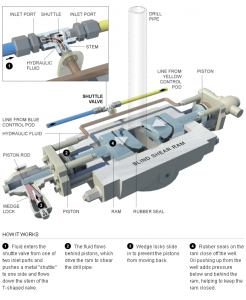A well-site leader and BP employee testified before the US Coast Guard investigatory committee that there was a problem with a safety device on the drilling rig; he reported the problem; but drilling presumably continued in a complete disregard for any attention to the problem.
Ronald Sepulvado testified that he reported a problem with the control pod connected to the blow-out preventer and could not understand why drilling continued or the company ignored his report. Ironically, Mr. Sepulvado was not on board the rig at the time of the explosion because he was attending a blow-out preventer safety training program.
The best guess is Mr. Sepulvado is talking about the shuttle valve located inside the Blind Shear Ram on the drilling pipe. The operation of this unit, as well as the entire component, is superbly illustrated on the New York Times website. Once again, the Times provide wonderful insight into this issue.
A failure of the shuttle valve can result in a malfunction of the blind ram shear. Imagine the drill pipe going down to the well head at the bottom of the ocean and on the well head is a hydraulically activated set of arms that, in the event of an emergency, should activate to cut the drill pipe, crimp the end of the pipe where oil flows and create a seal to prevent oil from blowing out into the entire Gulf.
Illustration Courtesy of NY Times Website
The Blow-out preventer can be activated in essentially (4) ways:
- Electrical Control Signal: sent from the surface through a control cable;
- Acoustical Control Signal: sent from the surface based on a modulated/encoded pulse of sound transmitted by an underwater transducer;
- ROV Intervention: remotely operated vehicles (ROVs) mechanically control valves and provide hydraulic pressure to the stack (via “hot stab” panels);
- Deadman Switch / Auto Shear: fail-safe activation of selected BOPs during an emergency, and if the control, power and hydraulic lines have been severed.
In the United States waters, oil rig operators such as BP and owners, such as Transocean, are permitted to outfit the rigs with only electrical controls, avoiding the deployment of acoustical controls. The omission of acoustical controls transmits into a savings of up to $500,000 per unit. Since rigs sometimes require replacement of these units, omitting the acoustical control can actually result in even more savings.
We can only reflect and wish that BP or Transocean had seen the wisdom of employing all of the safety mechanisms available to have avoided this disaster or that BP had listened to the voice in the wilderness of its own employee, Ronald Sepulvado.
Share This



